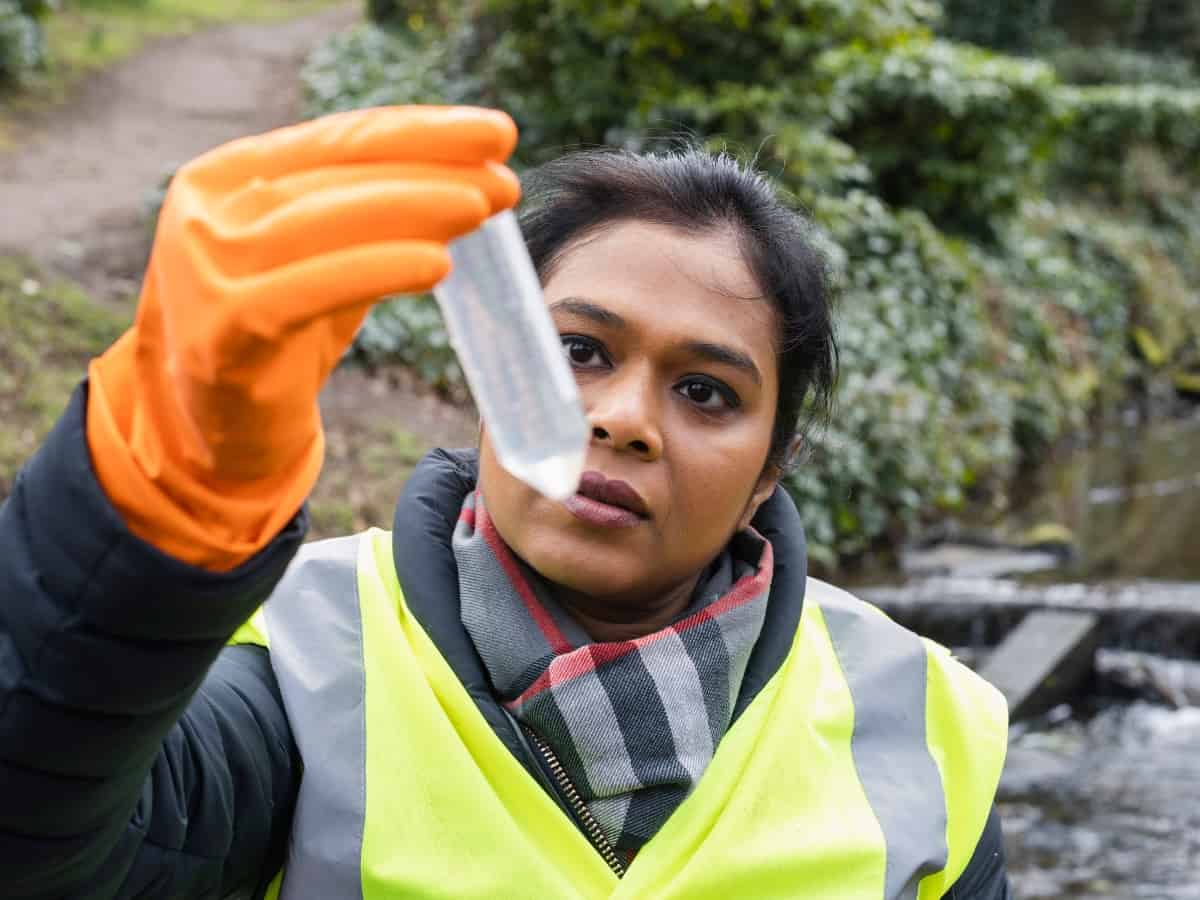Do you ever wonder what’s in your drinking water? The answer for those in the U.S. is probably “not much.” American water is one of the safest in the world, thanks to our rigorous treatment and filtration standards. However, even though our water is mostly safe, some contaminants can still slip through. One of these is PFAS (per-and poly-fluoroalkyl substances). So, do refrigerator water filters remove PFAS from your home water?
In a nutshell, refrigerator filters do not remove PFAS from your water. However, they are excellent at removing chlorine, tastes, and odors. Unfortunately, research shows that very few water filters can remove PFAS.
So, what does this mean for you and your family? It means there are better choices for removing PFAS and other contaminants than a refrigerator filter. It’s crucial to go for water filters that effectively eliminate PFAS, especially if you live where these contaminants are common.
Understanding PFAS
The presence of PFAS has been under scrutiny in recent years as the harmful effects of these chemicals have come to light. In particular, there is concern about PFAS in drinking water. While the Environmental Protection Agency (EPA) has set a drinking water limit for two types of PFAS, there are no federal regulations for other types of PFAS. EPA has set PFAS levels for perfluorooctanoic acid (PFOA) and perfluorooctane sulfonate (PFOS), the two most common types.
According to research by the Centers for Disease Control (CDC) and Prevention’s National Health and Nutrition Examination Survey (NHANES), 97% of Americans had PFAS in their blood.
So, what is PFAS? The per-and poly-fluoroalkyl substances are a group of chemicals used in various industries for over 50 years. You can find them in almost everything, from non-stick cookware to Stainmaster carpets to waterproof clothing. They are also in firefighting foams, which is how firefighters can come into contact with them.
PFAS are also called “forever chemicals” because they do not biodegrade. As a result, some they can take over 1000 years in the environment.
How do chemicals get into my water if they are used in industries during production? The forever chemicals are everywhere; air, soil, and water. They can easily enter water sources through surface runoffs, spills, and leakages. These chemicals are more common in areas where PFAS was used during the production of some products. You can also find high levels of PFAS in the water near military bases and airports. In 2000, industries that used PFAS in their manufacturing processes started phasing out its use. All production using these chemicals was effective in 2015. However, due to their persistent nature, these chemicals are still in the environment. That’s why you may find them in your drinking water.

Types of PFAS
Furthermore, new PFAS have been introduced, which may also negatively affect human health. GenX and PFBS are replacements for PFOA and PFOS, respectively. Research shows that there are over 9,000 PFAS identified. Some PFAS includes:
- Perfluorooctanoic acid (PFOA)
- Perfluorooctane sulfonic acid (PFOS)
- Hexafluoropropylene oxide dimer acid (GenX)
- Perfluorononanoic acid (PFNA)
- Perfluorobutane Sulfonate (PFBS)
- Perfluorooctylsulfonyl fluoride(POSF)
- Perfluorohexanesulfonic acid (PFHxS).
- Perfluorotetradecanoic acid (PFTeDA, or PFTA)
- Sodium perfluorooctanoate (NaPFO)
Do Refrigerator Water Filters Remove PFAS From Water?
No. Refrigerator water filters cannot remove PFAS in your water. However, they are effective at eliminating chlorine, tastes, and odors. Fridge water filters use activated carbon to remove contaminants, and because they are not meant to eliminate PFAS, they do it partially. Refrigerator water filters use activated carbon technology to adsorb contaminants from the water. This method employs a carbon block that attracts pollutants like a magnet. So, the contaminants stick to the carbon surface area, allowing clean water to pass.
Fridge water filters used are certified by NSF/ANSI 42, which authenticates water treatment equipment for aesthetic impurities. Unfortunately, this means refrigerator water filters cannot effectively remove inorganic pollutants, heavy metals, and bacteria.
If you’re looking for a high-quality filter that can remove PFAS in your water, go for those with NSF/ANSI 53 and NSF/ANSI 58 standards. Filters that have NSF/ANSI 53 certification are designed to reduce disease-causing contaminants. On the other hand, NSF/ANSI 58 certifies point-of-use filters that use reverse osmosis technology. When you use the refrigerator filter for some time, they become less efficient and reduce contaminants. That’s why experts recommend replacing the filter every six months. You can also replace it if you notice a decrease in the water flow.

What Are the Potential Health Effects of PFAS?
Drinking water that is contaminated with PFAS can lead to adverse health effects. Once exposed to these toxins, they can settle in your blood, kidney, lungs, and liver. Unfortunately, once these chemicals enter your body, they can take a long time to leave. Unlike many other substances that your body can quickly excrete through urine, PFAS leaves the body slowly over time. However, the duration depends on the type of PFAS you’re exposed to. For example, it can take PFOS 2-4 years to reduce in your blood naturally, assuming that you were not exposed again.
Affect On Your Body
According to the Agency for Toxic Substances and Disease Registry (ATSDR), you can also excrete some PFAS through menstruation or breast milk. An excellent example is a study that explored 6,018 adults aged ≥ 60 years to determine factors that affect PFAS levels. Men had higher levels of PFAS than women. The more PFAS you are exposed to, the more the chemicals bioaccumulate in your body, putting your health at risk for things like:
- Growth delays in children
- Reduced vaccine response in kids
- Reduced immunity
- Increased cholesterol levels /obesity
- Hormonal imbalance
- Risk of liver and kidney diseases
- Cancers such as kidney, testicular, prostate, and ovarian cancers, and non-Hodgkin lymphoma
In 2016, EPA set PFAS levels for PFOA and PFOS to 70 parts per trillion (ppt). However, on June 15, 2022, the agency issued a health advisory updating the PFOS levels to 0.02 ppt and 0.004 ppt for PFOA. The best technology for removing PFAS from your home water is granular activated carbon GAC) and reverse osmosis. Research shows that activated carbon filters can remove an average of 73% of PFAS. Likewise, under the sink, reverse osmosis filters are recommended since they can remove 93% of PFAS contaminants from your water.
You can combine activated carbon and reverse osmosis technology for more effective results.
How Do I Check if My Water Has PFAS Contamination?
You can contact the local water utility company if you’re using city water. Although water from the public water system is constantly tested and treated, the best option is to do a water test. A water test helps you determine your water quality for peace of mind and your family’s health.
It’s crucial to remember that any water, whether it comes from a well, a municipal system, or rain, could be contaminated with PFAS. You can contact professionals to help you test your water. You can also DIY, but having experts do the job for you is a better option since they can give you solutions depending on the results. In addition, they have the experience and can help interpret your water test results. Most companies will do the test for free, so take advantage of this opportunity to ensure your family is safe.
Do routine water tests if you live in an area where PFAS pollution is known to exist to keep your family safe. The PFAS exchange site can be a great place to start if you need clarification on whether there are any PFAS contamination sites close to your home. You can also get in touch with people dealing with similar water-related issues.

Can a Whole Home Water Filtration System Remove PFAS?
A whole home water filtration system from ONIT Home can remove 99% of contaminants from your water. This includes PFAS, debris and sediments, bacteria and viruses, calcium, magnesium, chlorine, chloramines, and more. The whole home water filtration system is installed by the main water line. This ensures that all the water in your home is clean for drinking, cleaning, and showering.
Enjoy Clean Water and Good Health with ONIT Home
Do refrigerator water filters remove PFAS from your home water? Unfortunately, no. Refrigerator water filters reduce PFAS contaminants but do not remove them. These filters are designed to remove chlorine, taste, and odors from water. Consider a whole-home water filtration system if you’re thinking about purchasing a water filter that removes PFAS from tap water. This system effectively removes most contaminants, leaving you with clean and better-tasting water.
Now that you know the answer to the question “do refrigerator water filters remove PFAS?”, let’s inform you about the best water filters that guarantee clean and safe water.
At ONIT Home, we pride ourselves on using the best technology for our filters. However, we also understand that every home is different. That’s why we customize your water filtration system to meet your home’s needs. To do so, we’ll first have to do a water test to determine te contaminants in your water. A water test helps us determine your water quality to design a high-quality system for you. Call us today at 1-833-433-0331 or visit us online for more information. Need clean water? We’re ONIT!



